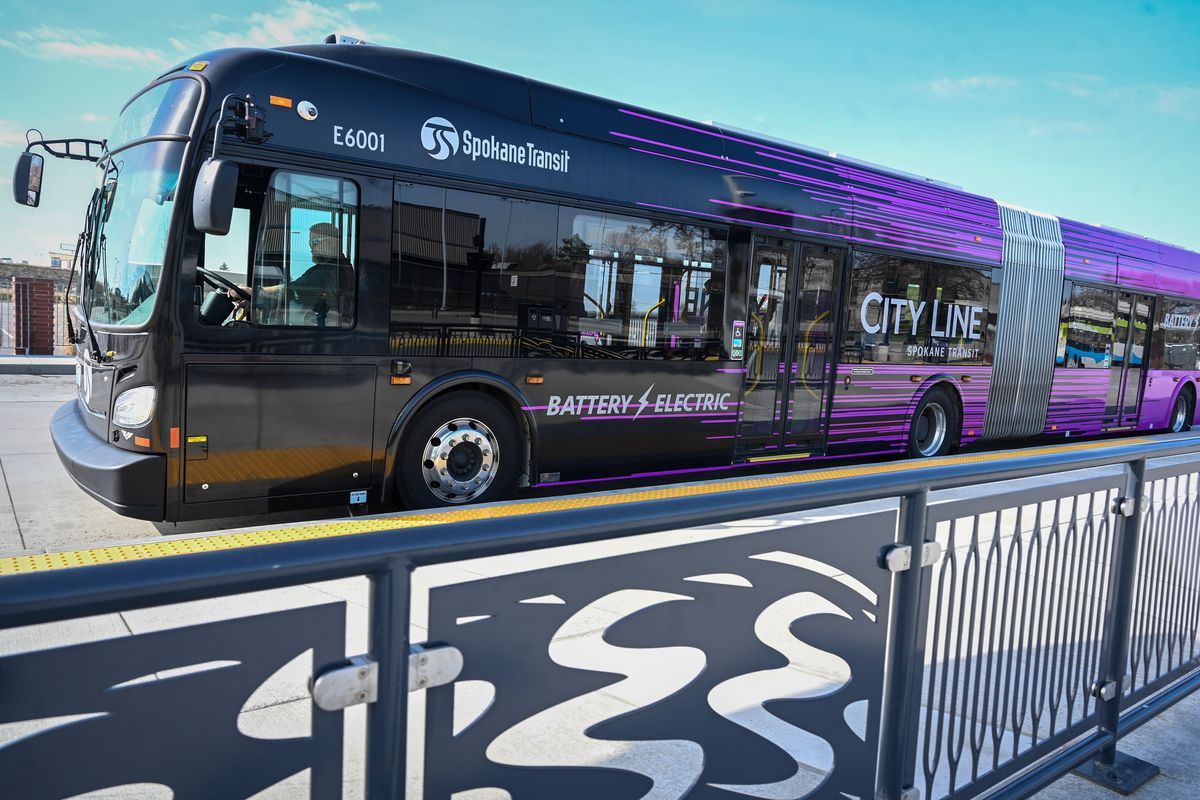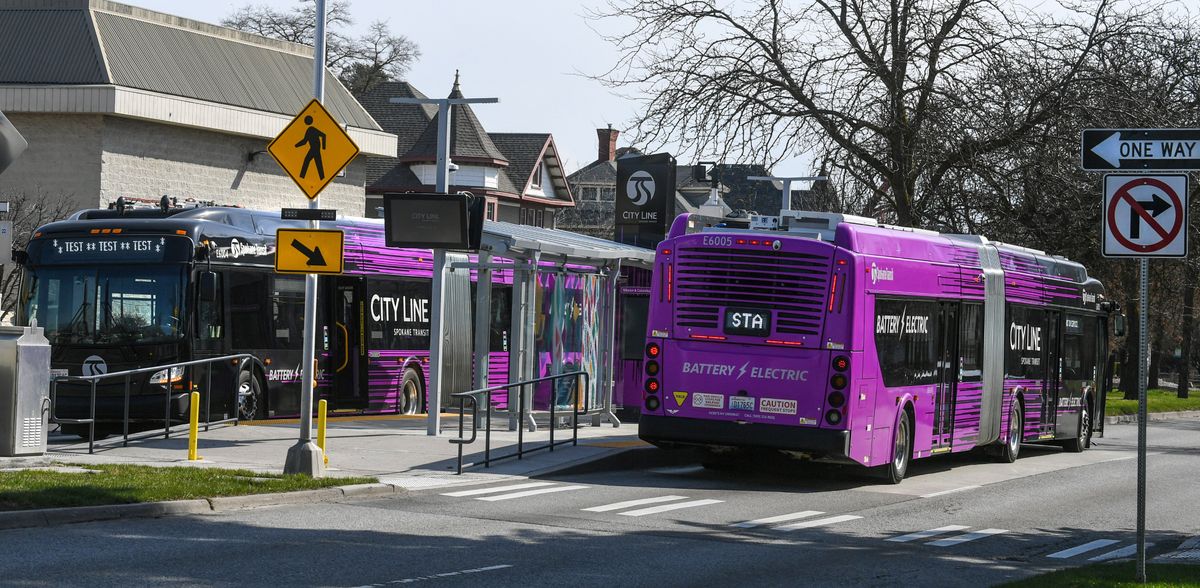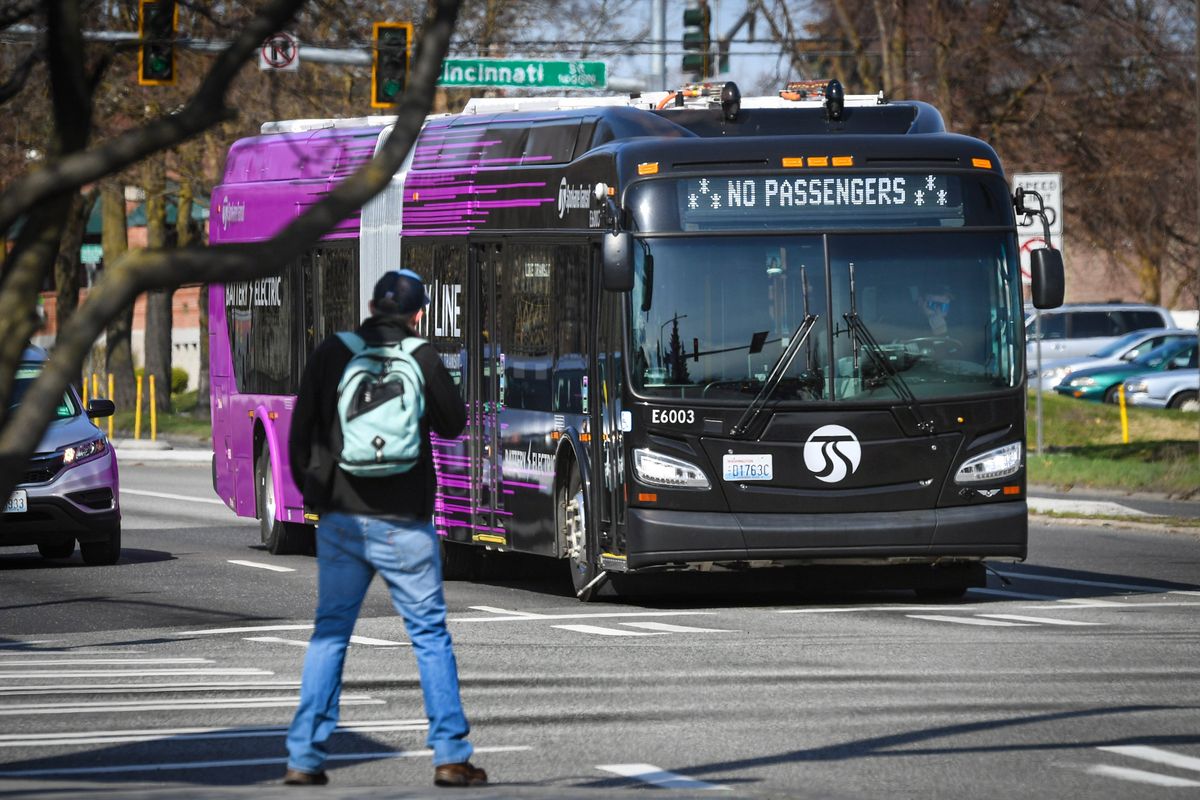Getting There: Spokane Transit Authority finishing kicking the tires before City Line rollout
A new City Line bus pauses at a red light heading east on Mission Avenue at Hamilton Street on Friday in Spokane. The City Line has been test-driven along the route since mid-January, and it’s set to launch July 15. (DAN PELLE/THE SPOKESMAN-REVIEW)Buy a print of this photo
Though the launch of the City Line bus route is still three months away, the large purple buses have been winding their way through Spokane all year as drivers test the new vehicles.
There’s a lot to work out, including teaching the new route and how to handle the unique prepaid boarding through all five doors. Drivers also have to practice lining the electric bus up to top-down rapid charging stations, while system administrators need to choreograph the complicated dance of getting buses quickly to their next destination with adequately full batteries.
At least one major road bump has already been identified: There aren’t enough drivers for the line to operate at full capacity. When it launches July 15, the City Line is projected to reach a given stop every 15 minutes, not the originally promised 71/2 minutes during peak hours and 10 minutes between 9 a.m. to 3 p.m.
“We’ll be hiring more throughout the next year, but we didn’t meet the staffing projections needed to deliver the original level of service we expected to have,” said Carly Cortright, Spokane Transit Authority spokeswoman.
STA’s struggles to hire staff are not unique to the agency, Cortright noted. Still, the agency expects to have staffing for full service by May 2024.
In the meantime, every driver on staff is getting some experience driving the new 60-foot, zero-emission vehicles. Though there will be a dedicated team of drivers, and drivers throughout the agency will be able to bid on the route in a couple of weeks, every driver needs to get some experience in case of unexpected illness or other absence.
While simulations have been taking place since mid-January, one of the most important practice runs is coming up next month: rider testing. STA is asking for volunteers to ride the City Line for one hour either May 10 or 11.
Riders will be given free City Line commemorative baseball caps, which they will wear so drivers can identify them as volunteers for the test runs. The agency hopes volunteers can help identify any remaining problems, such as the legibility of digital reader boards or the ease of boarding with a mobility device.
“If we have missed the mark somewhere, we can make final adjustments,” Cortright said. “We have been simulating our stops, but this will be a chance for drivers to test real-life conditions.”
A long time coming
Pia Hallenberg has been waiting a long time to be able to leave her car at home.
“I live in one end of downtown and work on the other end,” said Hallenberg, chair of the Riverside Neighborhood Council. “I would truthfully never have to take my car out of my garage again for work.”
A rapid transit line that connects the core of Spokane from east to west has been discussed for more than a decade. For Hallenberg and her neighbors, the route running from Browne’s Addition in the west to Spokane Community College in the east can’t come soon enough.
“If you live downtown and have a car, then parking is at a premium,” she said. “Maybe your apartment building is old and doesn’t have parking and you have to park on the street, which costs money, or you get a spot in a parking garage, which costs more.”
Rick Biggerstaff, the former chair of the Browne’s Addition Neighborhood Council who worked with STA during the planning of the City Line, predicts his neighbors in particular will benefit from the new route.
“We have such a high density neighborhood, and we’re an 80% renter neighborhood, so a lot of people here are using public transportation,” he said.
While the City Line’s initially lower-than-expected frequency is disappointing, Biggerstaff said he still expects it will be a significantly more efficient way for commuters along its route.
Biggerstaff also praised the transit authority for its spirit of collaboration during the planning stages of the City Line. Some in his neighborhood had been concerned that the design of the bus stops would clash with Browne’s Addition’s historic character, for example, and the agency worked with residents to make modifications.
“They were very responsive to our questions,” he said. “It’s hard to be perfect, and sometimes we weren’t getting some things, but every time we contacted them they stopped and tried to work with us.”
A quick zap
Forget the standard electric vehicle chargers, which look like a high-tech gas pump. Instead, picture a scene out of a space opera: As a shuttle noses into place, a docking station hisses downward from the station and locks on.

It’s a similar image as the 60-foot lilac -colored City Line buses slide into Spokane Community College, lining up beneath a rapid charging docking unit that lowers from the top down. These fast-charging stations can fill the battery from empty in about 100 minutes, or 1% per minute, said Spokane Transit Authority Chief Operations Officer Brandon Rapez-Betty.
But if system administrators carefully choreograph the City Line, that charge will last the whole day, sipping power intermittently along the way.
City Line buses come equipped with a battery capacity of 320 kilowatt hours, enough to give it a max range of between 120 and 150 miles. When the City Line starts operating at full capacity next May, that charge will be enough to run nonstop during peak hours, draining about 80% of the battery during the process, Rapez-Betty said.
After that, the bus will use every charging opportunity to get a little more power that it will use in the next run. After a roughly 15-minute charging time, the bus will complete another route, using less than half of that power along the way.
By the end of the day, the buses will return to the depot mostly charged, meaning chargers will be available for other vehicles with different charging requirements, Rapez-Betty said. That will be particularly helpful going forward, as STA adopts more electric buses.
The agency is looking at including longer-range buses in its fleet in the future, such as the 675-kilowatt hour, 300-mile max range bus manufactured by Proterra. Unlike the City Line buses, these higher-capacity batteries can’t guzzle electricity from the rapid chargers and instead need to rely on “depot chargers,” the more traditional plug-in chargers.
“The larger battery capacity helps achieve longer range, but that battery type requires depot charging,” Rapez-Betty said. “They can’t accept energy at the same rate.”
Work to watch for
The southeast shoulder at Indian Trail Road and Lowell Avenue will close Monday for installation of a pedestrian beacon for the crosswalk, as well as to improve the street and sidewalk for pedestrians.
Market Street will close between Garland and Columbia avenues, with traffic detoured to Haven Street, as part of intersection work in Hillyard in anticipation of the completion of the North Spokane Corridor.
Grind and overlay work is expected to close Lyons Avenue between Division and Addison streets on Thursday, dependent on weather conditions.


